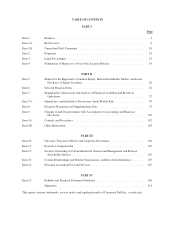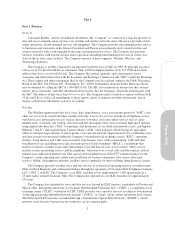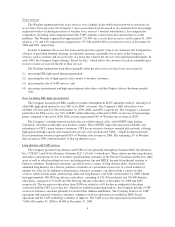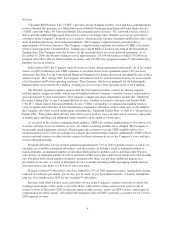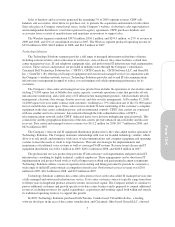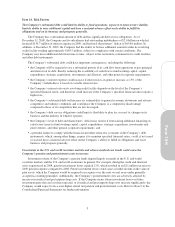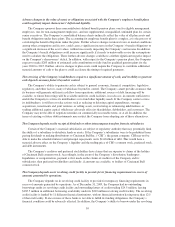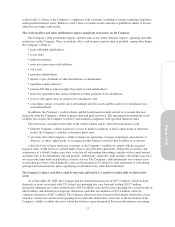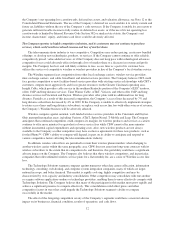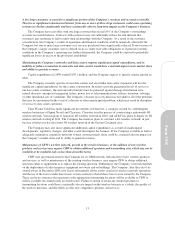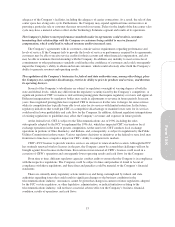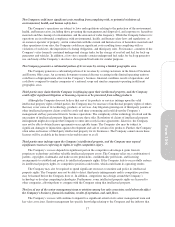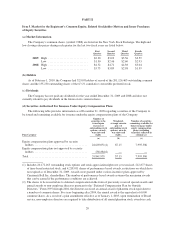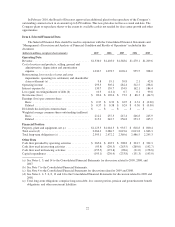Cincinnati Bell 2009 Annual Report Download - page 82
Download and view the complete annual report
Please find page 82 of the 2009 Cincinnati Bell annual report below. You can navigate through the pages in the report by either clicking on the pages listed below, or by using the keyword search tool below to find specific information within the annual report.the Company’s net operating loss carryforwards, deferred tax assets, and valuation allowance, see Note 12 to the
Consolidated Financial Statements. The use of the Company’s deferred tax assets enables it to satisfy current and
future tax liabilities without the use of the Company’s cash resources. If the Company is unable for any reason to
generate sufficient taxable income to fully realize its deferred tax assets, or if the use of its net operating loss
carryforwards is limited by Internal Revenue Code Section 382 or similar state statute, the Company’s net
income, shareowners’ equity, and future cash flows could be adversely affected.
The Company operates in highly competitive industries, and its customers may not continue to purchase
services, which could result in reduced revenue and loss of market share.
The telecommunications industry is very competitive. Competitors may reduce pricing, create new bundled
offerings, or develop new technologies, products, or services. If the Company cannot continue to offer reliable,
competitively priced, value-added services, or if the Company does not keep pace with technological advances,
competitive forces could adversely affect it through a loss of market share or a decrease in revenue and profit
margins. The Company has lost, and will likely continue to lose, access lines as a part of its customer base
utilizes the services of competitive wireline or wireless providers in lieu of the Company’s local wireline service.
The Wireline segment faces competition from other local exchange carriers, wireless service providers,
inter-exchange carriers, and cable, broadband, and internet service providers. The Company believes CBT could
face greater competition as new facilities-based service providers with existing service relationships with CBT’s
customers compete more aggressively and focus greater resources on the Greater Cincinnati operating area.
Insight Cable, which provides cable service in the northern Kentucky portion of the Company’s ILEC territory,
offers VoIP and long distance services. Time Warner Cable, AT&T, Verizon, and others offer VoIP and long
distance services in Cincinnati and Dayton. Wireless providers offer plans with no additional fees for long
distance. Partially as a result of this increased competition, the Company’s access lines decreased by 7% and
long distance subscribers decreased by 4% in 2009. If the Company is unable to effectively implement strategies
to retain access lines and long distance subscribers, or replace such access line loss with other sources of revenue,
the Company’s Wireline business will be adversely affected.
Wireless competes against national, well-funded wireless service providers in the Cincinnati and Dayton,
Ohio metropolitan market areas, including Verizon, AT&T, Sprint Nextel, T-Mobile and Leap. The Company
anticipates that continued competition could compress its margins for wireless products and services as carriers
continue to offer more minutes for equivalent or lower service fees while CBW cannot offer more minutes
without incremental capital expenditures and operating costs. Also, new wireless products are not always
available to the Company as other competitors may have exclusive agreements for these new products, such as
for the iPhone™. CBW’s ability to compete will depend, in part, on its ability to anticipate and respond to
various competitive factors affecting the telecommunications industry.
In addition, wireless subscribers are permitted to retain their wireless phone numbers when changing to
another wireless carrier within the same geographic area. CBW does not enter into long-term contracts with its
wireless subscribers to the extent that its competitors do, and therefore, this portability could have a significant
adverse impact on the Company. The Company also believes that these wireless competitors, and in particular,
companies that offer unlimited wireless service plans for a flat monthly fee, are a cause of Wireline access line
loss.
The Technology Solutions segment competes against numerous other data center collocation, information
technology consulting, web-hosting, and computer system integration companies, many of which are larger,
national in scope, and better financed. This market is rapidly evolving, highly competitive and may be
characterized by over-capacity and industry consolidation. Other competitors may consolidate with one another
or acquire software application vendors or technology providers, enabling them to more effectively compete with
Technology Solutions. The Company believes that many of the participants in this market must grow rapidly and
achieve a significant presence to compete effectively. This consolidation could affect prices and other
competitive factors in ways that could impede the Technology Solutions segment’s ability to compete
successfully in the market.
The effect of the foregoing competition on any of the Company’s segments could have a material adverse
impact on its businesses, financial condition, results of operations, and cash flows.
12


